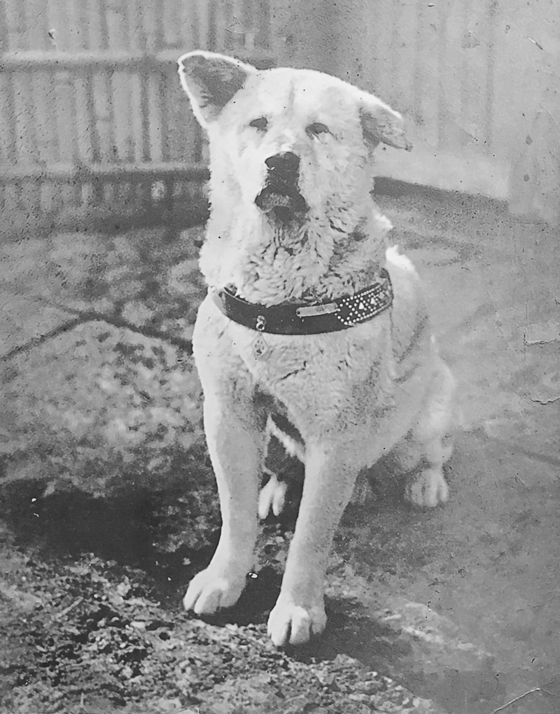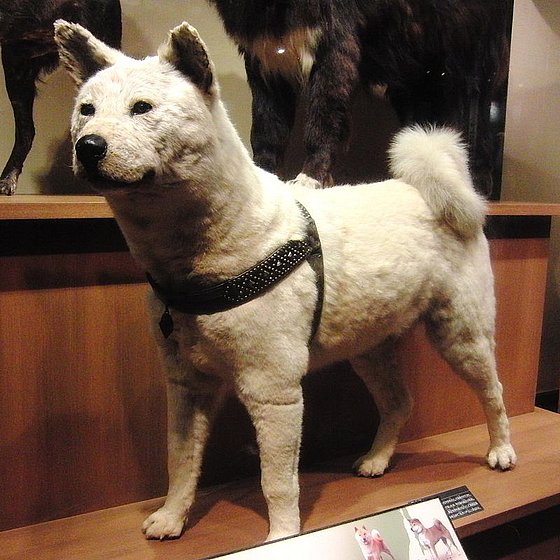
Hachikō, the most faithful dog in the world
Dr. Heike Baranzke / Theological Ethics of Catholic Theology
Photo: UniService Transfer
Hachikō, the most faithful dog in the world
The theologian Heike Baranzke on the ambivalent human-animal relationship on the occasion of the 100th birthday of an extraordinary dog
Hachikō (the additional syllable 'ko` means 'little gentleman`) was the name of a purebred Akita dog from Japan who became the epitome of loyalty. He was born on 10.11.1923 and belonged to a university professor. He accompanied him every morning to the train station and picked him up there again in the evening. After the professor died unexpectedly, Hachikō nevertheless came to the station every day until the end of his life to look out for his master. Ms. Baranzke, Shintoism is widespread in Japan. The Shinto concept of death exists in parallel: when a person dies, his soul ("tama") remains on earth for between 33 and 49 years and continues to exert influence on the living, after which he enters the realm of his own ancestors. He becomes one with the family "kami", the divine and supernatural beings. All can be "kami" in Shintoism, including animals. But in the Christian religion, animals have a different status, don't they?
Baranzke: Unlike Shintoism, the Christian religion, like the Jewish and Islamic religions, belongs to the book religions that refer to a holy scripture. The Jewish holy scripture forms the so-called Old Testament, or as we say today in awareness of the Jewish-Christian connection, the First Testament, i.e. the first and more extensive part of the Christian Bible. This also contains the vast majority of the influential creation-theological texts that trace everything in the world, all plants, animals, and humans, back to a good Creator God. Some creation texts, such as the well-known story of Paradise and Psalm 104, as well as verses from Kohelet, emphasize that animals and humans are even considered to be those creatures that have in common to have been animated by the breath of the Creator God and to be kept alive. Biblical creation texts and Shintoism obviously both emphasize a special primordial closeness between humans and animals. I am not an expert on Japanese Shintoism, but I have done a little research and I see that Shintoism is considered to be a nature religion, which - also in this respect similar to the old creation theological texts - reflects the time of the closeness to nature that was shaped by the agrarian way of life. However, this still says little about how people dealt with animals - and especially which animals - in concrete terms, or even how they should deal with them.
Hachikō walked to the train station every day until his death in 1935 to wait for his master. This testifies to an extraordinary amount of affection and empathy. Do animals actually go to heaven?
Baranzke: I immediately have to ask: What does heaven actually stand for in this question? In English, for example, a distinction is made between "sky" and "heaven" for the physical and the symbolic heaven. The question obviously aims at a symbolic meaning of heaven, at an imaginary place where people and their pets remain connected even after death, that is, are not separated by death. Whether Hachikō's behavior is evidence of fidelity is, from a scientific perspective, first of all an anthropomorphism (an anthropomorphism is the transfer of human characteristics to non-human beings, ed.). We attribute this to the animal, as if it was a free character formation of the dog. But is it not rather the projection surface for our, in the society for many reasons unsatisfied utopias and longings? Are the animals - and dogs take here once again a special role - in principle the reservoir, on which we project all our longings, in particular such, whose fulfillment we humans remain too often owed to each other? What else do we expect from heaven? First of all it is to be stated that animals, because they do not have the moral abilities to evaluate their behavior once again themselves, are not capable of ethical reflection. They cannot actually justify what is good and what is evil, but one could say with Konrad Lorenz, the famous behavioral scientist: Animals are emotional people. They always react somehow spontaneously according to their feelings and do not pretend, they also do not have a sensus for our social differences and social evaluations that we make and in this sense they also do not lie. Of course, that's also something we humans want from each other, to be able to rely on expressions of sympathy. But with us this is a free choice, animals on the other hand cannot pretend. Therefore, we are inclined to see heaven in them, because we actually want from each other also an undisguised and a reliable behavior.
Hachikō was beaten, graffitied, and silently tolerated at the station in his early years until a stationmaster took care of him and set up a resting place for him. Animal welfare has a long history behind it, and since May 17, 2002, it has even had constitutional status in Germany. On May 10, 2021, the United Kingdom became one of the first European countries to enshrine animal feelings in law. Animal ethics is now part of the almost self-evident repertoire of basic ethical concepts. What has triggered this change in meaning?
Baranzke: There are many factors that have triggered it. On the one hand, it is a very fundamental change in the world view, above all due to the development of the modern natural sciences in the early modern period. This strengthened the empirical perception from an orientation toward the beyond to an orientation toward this world. At the same time, the perception of what is important to us in this earthly life, namely the ability to feel and to suffer, etc., came more to the fore. Intradenominational developments also played a role. Protestantism in particular turned to an ethic of responsibility, namely the view that because of the doctrine of original sin, man was responsible for suffering in the world, and he must now also bear responsibility to reduce this suffering in the world. These Protestant impulses assumed that man could contribute to hastening Christ's return if he prepared the way for it by acting accordingly out of charity. Thus, in the course of the 18th century, a protoecological discussion emerged in Protestantism. There were discussions about animal protection, animal rights and animal welfare, and in addition to soup kitchens for the poor, the first animal protection societies were founded in the 19th century, so that the theological discussion actually gave rise to impulses for action. Charity was also extended to animals and this momentum continues to this day, even if the Protestant background is hardly conscious anymore.
In contrast, the Catholic tradition previously had a purely creation-spiritual relationship, much like Islam still does today. And I suspect that this is also comparable in Shintoism. Traces of God were seen in the creatures, but it remained rather a theoretical spirituality. What also comes in addition, of course, are social movements. There were the farm animals on one side and the lapdogs patted by the nobility on the other. The bourgeoisie liked to orient themselves on the nobility and then also acquired pets as purpose-free playmates. There were very many influences to consider here.

Hachikō, undated photograph, public domain
A year before his death, a monument was erected to the dog at Shibuya Station. We also know dog monuments. In Solingen, for example, there is the so-called Rüdenstein, which honors a dog that, according to legend, saved the life of the young duke Robert von Berg after he fell from his horse. These are examples that show how connected people feel with animals. They say: "Animals experience our speech melody, the way we move and of course the smells. And based on that, communication is also possible." But a soul has long been denied to animals. Has that changed today in Christian theology?
Baranzke: You first have to see where the soul concept actually comes from. The concept of the soul was not a concept of the Hebrew religion, but it is a concept of Greek philosophy, especially of the Platonic and Aristotelian conception and has thereby also influenced Christian theology. In this sense, then, animals were never actually without a soul, because the soul was first a principle of life. The human-animal-soul difference was seen in the early times of the philosophical tradition in the fact that only the human being was attributed an imperishable, an immortal soul due to his ability to reason. The fact that animals with a perishable life-soul were also denied sentience was a very late philosophical development of the 17th century by the philosopher René Descartes and has something to do with the mechanization of the world view in the early modern era.
The connection that man sees with the animals is of course the liveliness and the ability to feel and the projection surface for many things that we wish for or do not wish for, because the question is also: Do rats, tarantulas or wasps also have a soul? Are we interested in addressing that as well?

Hachikō on display at the National Museum of Natural Sciences in Tokyo.
CC BY - SA 3.0
The legend about the Rüdenstein says something about the close relationship of the knight to his horse. This is a development that also exists in shamanism, which originated in the Mongolian region among the steppe peoples. There the horse also has a special role. So landscape and geographically conditioned, not only as a meat supplier, but as a transport animal. It was so highly estimated that if then the knight died, often also the horse was killed, in order to give it to him in the hereafter. I.e. the close relationship and the high esteem, which an animal experiences, can also quite result in the fact that it was killed as a grave gift. With the evaluation of old legends and legends one must ask again and again the question: What was the meaning-giving world view? The human-animal relationship is always ambivalent.
On March 8, 1935, the dog was found dead in a street. A day later, thousands of people flocked to Shibuya Station. Countless flowers decorated the square, and a Buddhist monk said a prayer for the four-legged friend. After the ceremony, Hachiko's body was prepared and is now in the National Museum of Natural Sciences in Tokyo. Ms. Baranzke, how would you describe our human-animal relationship today from an ethical perspective?
Baranzke: It has always been ambivalent. Today, I would say it is even more extreme, because we categorize animals very strongly according to their usefulness. Humans are the animals that, from an evolutionary point of view, have produced the most diverse forms of use and relationships with other animals, including highly ambivalent social and emotional relationships. We know that e.g. ants, milk aphids and to a certain extent operate their own animal husbandry, but man has nevertheless opened up quite ambiguous relationships in this respect. This is then reflected in many different categorizations, such as wild animals, domestic animals, farm animals. The term animal is already a philosophical abstract term. We see the dog as the first domesticated animal, because wolves and humans have similar social structures and also share the receptivity for the child schema, which has also preserved cultural memories in legends that wolves have also raised lost human children. There one thinks of the city foundation of Rome with Romulus and Remus. Or the story of Mowgli raised by wolves in Rudyard Kipling's Jungle Book. But what about the rats, the wasps, and the hornets? What moves me even more, and also draws a realistic frame with a critical look at this very touching story with Hachikō, is that we probably in the same way completely integrate some animals into families only quite sentimentally for the satisfaction of our emotional needs and no longer see them at all as a part of nature. This also has a very negative effect on the individual animal species, because they are treated anything but species-appropriate and also suffer extremely from this humanization. And it also shows that we no longer have an understanding of nature. The Japanese relationship to whaling is also discussed very controversially. Dolphins and whales are still being slaughtered for pseudo reasons, even though no one wants to eat them anymore and there is no need for it. Or the Japanese animal cafés, which exist only to create a sentimental petting relationship with animals. There, animals are kept in absolutely artificial environments, not only dogs, cats and guinea pigs, but also hedgehogs and owls, which are actually nocturnal, or even amphibians, which perceive human touch as total stress. There is still a need for some education in Japan.
Uwe Blass
Dr. Heike Baranzke is a lecturer in theological ethics of Catholic theology in the Faculty of Humanities and Cultural Studies at Bergische Universität.
